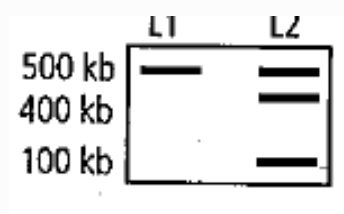A : Unknown DNA after hybridization with VNTR probe, the autoradiogram gives may bands of differing sizes in DNA profiling .
R: These bands represents DNA fingerpint of organism.
If both Assertion & Reason are true and the reason is the correct explanation of the assertion, then mark
If both Assertion & Reason are true and the reason is not the correct explanation of the assertion , then mark
If Assertion is true statement but Reason is false, then mark.
If both Assertion and Reason are false statements, then mark.
The correct Answer is:A
Step-by-Step Solution:
1. Understanding the Assertion (A): The assertion states that unknown DNA, after hybridization with a VNTR (Variable Number Tandem Repeat) probe, produces an autoradiogram with many bands of differing sizes in DNA profiling.
- Explanation: VNTRs are regions in the DNA that consist of repeated sequences. When DNA is subjected to techniques like hybridization with VNTR probes, these regions can be visualized as bands on an autoradiogram. The varying sizes of these bands indicate the different lengths of the VNTRs present in the DNA sample.
2. Understanding the Reason (R): The reason states that these bands represent the DNA fingerprint of an organism.
- Explanation: The unique pattern of bands produced by the VNTRs in an individual's DNA is often referred to as a DNA fingerprint. This pattern is unique to each organism (except identical twins) and can be used for identification purposes, such as in forensic science or paternity testing.
3. Evaluating the Truth of Assertion and Reason: Both the assertion and the reason are true. The assertion correctly describes the process of DNA profiling using VNTRs, and the reason accurately explains that the resulting bands are indeed a representation of the organism's DNA fingerprint.
4. Determining the Relationship: The reason provided is a correct explanation of the assertion. The bands observed in the autoradiogram are directly related to the concept of DNA fingerprinting, as they reflect the unique genetic makeup of the organism.
5. Conclusion: Therefore, both the assertion and the reason are true, and the reason is a correct explanation of the assertion.
Final Answer: Both assertion (A) and reason (R) are true, and R is the correct explanation of A.
---
Topper's Solved these Questions
- MOLECULAR BASIS OF INHERITANCE BOOK - AAKASH INSTITUTE ENGLISHCHAPTER - MOLECULAR BASIS OF INHERITANCE EXERCISE - ASSIGNMENT (SECTION -C) Previous Years Questions
139 Videos
- MOCK_TEST_20BOOK - AAKASH INSTITUTE ENGLISHCHAPTER - MOCK_TEST_20EXERCISE - EXAMPLE
31 Videos
- MORPHOLOGY OF FLOWERING PLANTSBOOK - AAKASH INSTITUTE ENGLISHCHAPTER - MORPHOLOGY OF FLOWERING PLANTSEXERCISE - TRY YOURSELF
38 Videos
Similar Questions
[A]: The base ratio (A+T )/(G+C) is constant in a particular organism.
[R]: The ratio is, however, different in the dif- ferent DNA molecules
View SolutionAfter electrophoresis the separated DNA fragment can be visualized ethidium bromide gel exposed UV light . These DNA fragments appear as _______ coloured bands :
View Solution
Knowledge Check
Study the given figure carefully and select the incorrect statements regarding this.

(i) It represents a typical agarose gel electrophoresis in which lane 1 contains undigested DNA
(ii) Smallest DNA bands are formed at A and largest DNA bands are formed at B
(iii) The separated DNA fragments can be visualized after staining in the visible light
(iv) The separated DNA bands are cut out from the agarose gel and extracted from the gel piece. this step is known as elution.A(i) and (ii)B(ii) and (iii)C(ii) and (iv)DPerson can see the bands without staining.The figure shows the restriction enzyme cutting sites (R1−R3) in wild type (n) and mutant (n) gene.

If a radioactively labelled probe (that hybridises at a sequence close to R1) is used for detecting the presence of DNA fragments after gel electrophoresis and Southern blotting, which of the following band patterns will yout expect ?
Note : L1 : wild type DNA, L2: mutant DNAA(a) B(b)
B(b) C(c)
C(c) D(d)
D(d)
After electrophoresis the separated DNA fragment can be vishualised ethidium bromide gel exposed UV light . These DNA fragments appear as _______ coloured bands :
View SolutionA mixture of fragmented DNA was electrophoresed in an agarose gel. After staining the gel with ethidium bromide, no DNA bands were observed. What could be the reasons?
View SolutionA plasmid DNA and linear DNA (both are of the same size) have one site for restriction endonuclease. When cut and separated on agarose gel electrophoresis, plasmid shows one DNA band, while linear DNA shows two fragments Explain.
View SolutionA plasmid DNA and a linear DNA (both are of the same size) have one site for a restriction endonuclease. When cut and separated on agarose gel electrophoresis, plasmid shows one DNA band while linear DNA shows two fragments. Explain
View SolutionA mixture of fragmented DNA was electrophoresed in an agarose gel. After staining the gel with ethidium bromide, no DNA bands were observed. What could be the reason?
View Solution
